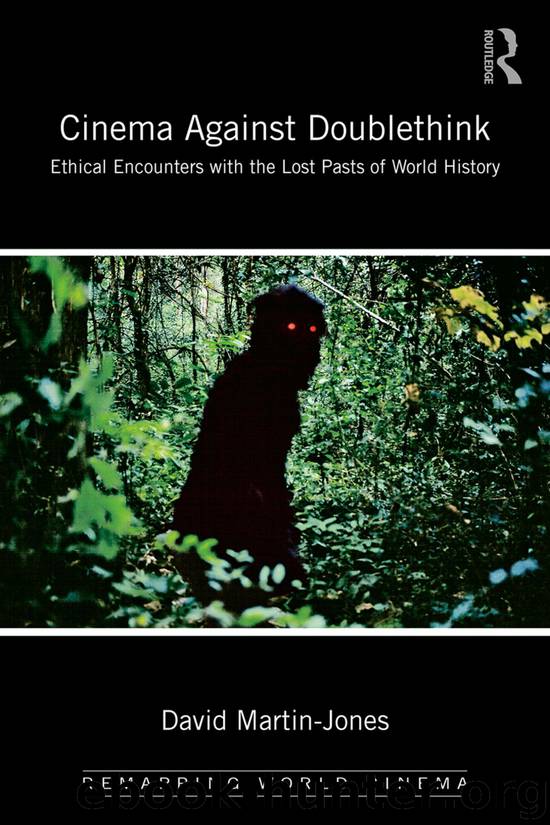Cinema Against Doublethink by Martin-Jones David

Author:Martin-Jones, David
Language: eng
Format: epub
Publisher: Taylor & Francis (CAM)
4
500YEARS
The North Atlantic trade circuit, the racial contract, encountering others’ pasts
This, the second of four chapters of film analysis, explores two films about intercultural encounters across the Atlantic which meditate on colonial modernity’s origins and contemporary form: Como Era Gostoso o Meu Francê s/How Tasty Was My Little Frenchman (Brazil, 1971), and Tambié n la lluvia/Even the Rain (Spain/Bolivia/Mexico/France, 2010). The films cover early Sixteenth Century colonial interactions between Europeans and indigenous Americans, with implicit resonances for the then Cold War present (How Tasty), and the neo-colonialism of contemporary globalisation (Even the Rain). These films are characterised by the time-images of the opsign and the crystal of time, respectively. They both conclude with an affection-image in which a direct address to the viewer breaches the fourth wall. The five-hundred-year transnational history on display in these time-images is that of the North Atlantic trade circuit. The films together explore how the entangled histories of white Europeans and indigenous cultures from 1492 onwards – histories integrally linked to the exploitation of the environments and natural resources they traverse (specifically brazil wood (How Tasty) and water (Even the Rain)) – have been rendered ‘lost pasts’.
The encounter with these lost pasts enables viewer hesitation with regard to what Charles W. Mills calls the racial contract, the role of which in determining this period of world history continues into the present. In How Tasty, the encounter with an eradicated indigenous past momentarily turns the racial contract on its head, as those typically excluded by it usurp the place occupied by the coloniser. The viewer is thus, perhaps unsettlingly for many, aligned with the position of the colonised. Even the Rain, similarly, emphasises the difficulty Europeans have engaging with the other (during the history of colonial modernity, as today), whilst foregrounding the crystal histories though which access can be granted to the lost pasts of world memory. In neither film do we learn about the history of the North Atlantic trade circuit per se. Rather, we encounter the awareness that it has denied coevalness to the people upon whose exploitation the global centrality of Europe was built after 1492.
Time-images: Others’ pasts
In How Tasty, the encounter between a would-be European coloniser in the early Sixteenth Century and an indigenous tribe of Tupi Indians in what is now Brazil occurs in a pure optical situation (or opsign). Opsigns are discussed by Deleuze amongst his time-image categories, to describe situations in which characters are unable to act so as to influence their destiny. Opsigns are actual images, but in them we see the passing of time for itself because they do not function within a sensory-motor oriented progression of images. In opsigns we encounter situations in which the continuity from perception to action has been suspended. Thus the inhabitant of the interval between the two becomes a (hesitant) seer, unable to act decisively upon what is perceived (as might a doer in the movement-image (1985, 1–2)). Tellingly, this suspended temporal moment, in which the European discoverer of the New World finds
Download
This site does not store any files on its server. We only index and link to content provided by other sites. Please contact the content providers to delete copyright contents if any and email us, we'll remove relevant links or contents immediately.
| Anthropology | Archaeology |
| Philosophy | Politics & Government |
| Social Sciences | Sociology |
| Women's Studies |
Cecilia; Or, Memoirs of an Heiress — Volume 1 by Fanny Burney(32413)
Cecilia; Or, Memoirs of an Heiress — Volume 3 by Fanny Burney(31824)
Cecilia; Or, Memoirs of an Heiress — Volume 2 by Fanny Burney(31810)
The Great Music City by Andrea Baker(31251)
We're Going to Need More Wine by Gabrielle Union(18951)
All the Missing Girls by Megan Miranda(15502)
Pimp by Iceberg Slim(14325)
Bombshells: Glamour Girls of a Lifetime by Sullivan Steve(13953)
Talking to Strangers by Malcolm Gladwell(13194)
Norse Mythology by Gaiman Neil(13177)
Fifty Shades Freed by E L James(13145)
For the Love of Europe by Rick Steves(12674)
Mindhunter: Inside the FBI's Elite Serial Crime Unit by John E. Douglas & Mark Olshaker(9164)
Crazy Rich Asians by Kevin Kwan(9147)
The Lost Art of Listening by Michael P. Nichols(7388)
Enlightenment Now: The Case for Reason, Science, Humanism, and Progress by Steven Pinker(7171)
The Four Agreements by Don Miguel Ruiz(6602)
Bad Blood by John Carreyrou(6522)
Weapons of Math Destruction by Cathy O'Neil(6116)
